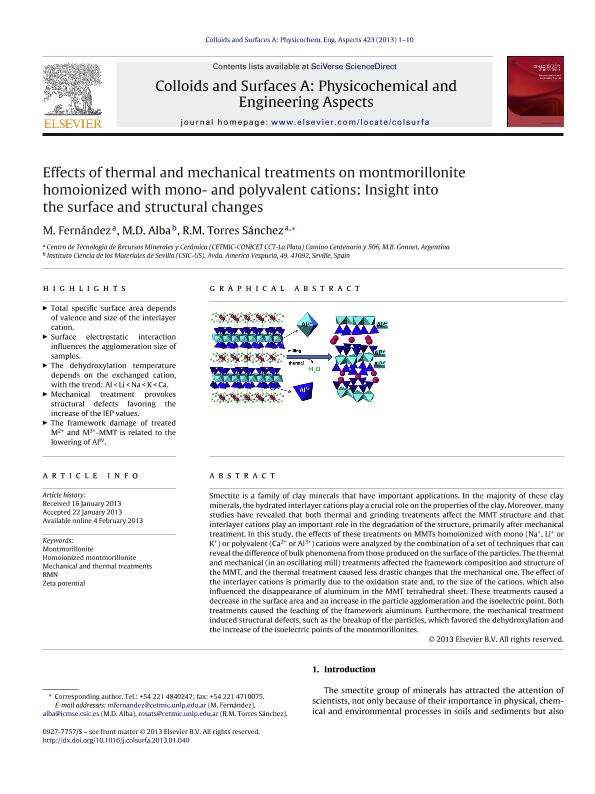Mostrar el registro sencillo del ítem
dc.contributor.author
Fernandez, Mariela Alejandra

dc.contributor.author
Alba, Maria Dolores
dc.contributor.author
Torres Sanchez, Rosa Maria

dc.date.available
2016-01-07T16:50:23Z
dc.date.issued
2013-02-04
dc.identifier.citation
Fernandez, Mariela Alejandra; Alba, Maria Dolores; Torres Sanchez, Rosa Maria; Effects of thermal and mechanical treatments on montmorillonite homoionized with mono- and polyvalent cations: Insight into the surface and structural changes; Elsevier; Colloids and Surfaces A: Physicochemical and Engineering Aspects; 423; 4-2-2013; 1-10
dc.identifier.issn
0927-7757
dc.identifier.uri
http://hdl.handle.net/11336/3404
dc.description.abstract
Smectite is a family of clay minerals that have important applications. In the majority of these clay minerals, the hydrated interlayer cations play a crucial role on the properties of the clay. Moreover, many studies have revealed that both thermal and grinding treatments affect the MMT structure and that interlayer cations play an important role in the degradation of the structure, primarily after mechanical treatment. In this study, the effects of these treatments on MMTs homoionized with mono (Na+, Li+ or K+) or polyvalent (Ca2+ or Al3+) cations were analyzed by the combination of a set of techniques that can reveal the difference of bulk phenomena from those produced on the surface of the particles. The thermal and mechanical (in an oscillating mill) treatments affected the framework composition and structure of the MMT, and the thermal treatment caused less drastic changes that the mechanical one. The effect of the interlayer cations is primarily due to the oxidation state and, to the size of the cations, which also influenced the disappearance of aluminum in the MMT tetrahedral sheet. These treatments caused a decrease in the surface area and an increase in the particle agglomeration and the isoelectric point. Both treatments caused the leaching of the framework aluminum. Furthermore, the mechanical treatment induced structural defects, such as the breakup of the particles, which favored the dehydroxylation and the increase of the isoelectric points of the montmorillonites.
dc.format
application/pdf
dc.language.iso
eng
dc.publisher
Elsevier

dc.rights
info:eu-repo/semantics/openAccess
dc.rights.uri
https://creativecommons.org/licenses/by-nc-nd/2.5/ar/
dc.subject
Montmorillonite
dc.subject
Homoionized Montmorillonite
dc.subject
Mechanical And Thermal Treatments
dc.subject
Rmn
dc.subject.classification
Química Coloidal

dc.subject.classification
Ciencias Químicas

dc.subject.classification
CIENCIAS NATURALES Y EXACTAS

dc.title
Effects of thermal and mechanical treatments on montmorillonite homoionized with mono- and polyvalent cations: Insight into the surface and structural changes
dc.type
info:eu-repo/semantics/article
dc.type
info:ar-repo/semantics/artículo
dc.type
info:eu-repo/semantics/publishedVersion
dc.date.updated
2016-03-30 10:35:44.97925-03
dc.journal.volume
423
dc.journal.pagination
1-10
dc.journal.pais
Países Bajos

dc.journal.ciudad
Amsterdam
dc.description.fil
Fil: Fernandez, Mariela Alejandra. Consejo Nacional de Investigaciones Científicas y Técnicas. Centro Científico Tecnológico La Plata. Centro Tecnológico de Recursos Minerales y Cerámica (i); Argentina
dc.description.fil
Fil: Alba, Maria Dolores. Instituto Ciencia de los Materiales de Sevilla; España
dc.description.fil
Fil: Torres Sanchez, Rosa Maria. Consejo Nacional de Investigaciones Científicas y Técnicas. Centro Científico Tecnológico La Plata. Centro Tecnológico de Recursos Minerales y Cerámica (i); Argentina
dc.journal.title
Colloids and Surfaces A: Physicochemical and Engineering Aspects

dc.relation.alternativeid
info:eu-repo/semantics/altIdentifier/url/http://www.sciencedirect.com/science/article/pii/S0927775713000617
dc.relation.alternativeid
info:eu-repo/semantics/altIdentifier/doi/http://dx.doi.org/10.1016/j.colsurfa.2013.01.040
Archivos asociados
